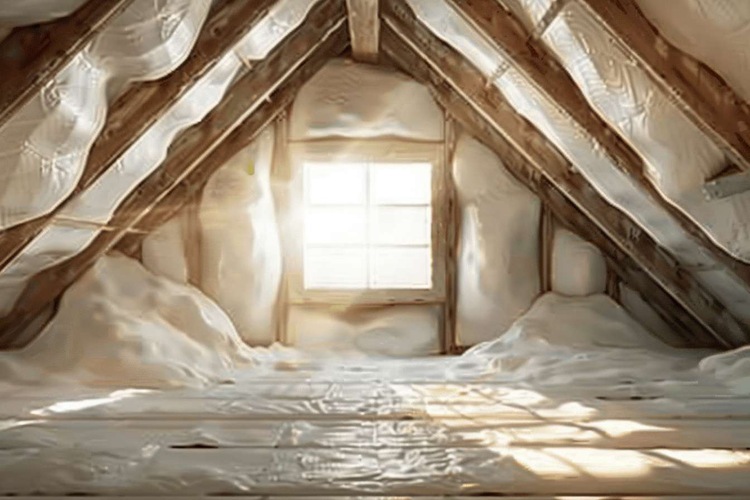SPRAY FOAM INSULATION: A COMPREHENSIVE GUIDE TO ENERGY-EFFICIENT HOME SOLUTIONS
Spray foam insulation has revolutionized the way we think about home insulation, offering superior thermal protection and energy efficiency. This innovative solution has gained popularity among homeowners and contractors alike, thanks to its ability to create an airtight seal and provide excellent insulation properties. In this comprehensive guide, we'll explore the ins and outs of spray foam insulation, its benefits, installation process, and why it might be the right choice for your home.

What exactly is spray foam insulation?
Spray foam insulation is a modern insulation material that expands upon application to fill gaps, cracks, and cavities in walls, attics, and other spaces. It’s composed of two main ingredients: polyol resin and isocyanate. When these components are mixed and sprayed, they react chemically, expanding up to 100 times their original volume and hardening into a rigid foam. This process creates a seamless, airtight barrier that effectively insulates and air-seals the treated area.
How does spray foam insulation compare to traditional options?
When comparing spray foam insulation to traditional options like fiberglass or cellulose, several key differences emerge. Spray foam provides a higher R-value per inch, meaning it offers better insulation with less thickness. Unlike traditional materials that can settle or leave gaps, spray foam expands to fill all spaces, creating a more effective air barrier. It also acts as a moisture barrier, reducing the risk of mold and mildew growth. While spray foam typically has a higher upfront cost, its superior performance and longevity often result in greater energy savings over time.
What are the main types of spray foam insulation?
There are two primary types of spray foam insulation: open-cell and closed-cell. Open-cell foam is lighter, more flexible, and less expensive. It’s excellent for sound dampening and is often used in interior walls. Closed-cell foam is denser, more rigid, and provides a higher R-value per inch. It’s more effective as a moisture barrier and is often preferred for exterior walls and areas prone to moisture. The choice between open-cell and closed-cell foam depends on factors such as the specific insulation needs, budget, and location within the home.
How is spray foam insulation installed?
The installation of spray foam insulation is a specialized process that requires professional equipment and expertise. First, the area to be insulated is prepared by removing any existing insulation and ensuring the surface is clean and dry. The two chemical components are then mixed in a spray gun and applied to the target area. As the mixture is sprayed, it expands rapidly, filling gaps and adhering to surfaces. The foam typically cures within minutes, though it may take up to 24 hours to fully set. Proper ventilation is crucial during and after installation due to the chemical nature of the process.
What are the benefits of spray foam insulation in Canada?
In Canada’s varied climate, spray foam insulation offers several unique advantages. Its excellent air-sealing properties are particularly beneficial in harsh winter conditions, significantly reducing heat loss and drafts. This can lead to substantial energy savings, with some homeowners reporting up to 50% reduction in heating and cooling costs. Spray foam’s moisture-resistant qualities are also valuable in Canada’s humid summers and snowy winters, helping to prevent ice dams on roofs and moisture infiltration in basements. Additionally, its ability to strengthen wall structures can be advantageous in areas prone to high winds or heavy snow loads.
What are the potential drawbacks and cost considerations?
While spray foam insulation offers numerous benefits, it’s important to consider potential drawbacks. The initial cost of spray foam insulation is typically higher than traditional alternatives, which can be a significant factor for some homeowners. Professional installation is required, adding to the overall expense. There are also environmental concerns related to the chemicals used in some spray foam products, although eco-friendly options are becoming more available.
| Insulation Type | Average Cost per Square Foot (CAD) | R-Value per Inch |
|---|---|---|
| Open-Cell Spray Foam | $0.90 - $1.50 | R-3.6 to R-3.8 |
| Closed-Cell Spray Foam | $1.50 - $2.50 | R-6.0 to R-7.0 |
| Fiberglass Batts | $0.50 - $1.00 | R-2.2 to R-2.7 |
| Blown-in Cellulose | $0.80 - $1.20 | R-3.2 to R-3.8 |
Prices, rates, or cost estimates mentioned in this article are based on the latest available information but may change over time. Independent research is advised before making financial decisions.
In conclusion, spray foam insulation represents a significant advancement in home insulation technology. Its superior insulating properties, air-sealing capabilities, and moisture resistance make it an attractive option for many Canadian homeowners. While the initial investment may be higher than traditional insulation methods, the long-term energy savings and improved home comfort can make it a worthwhile consideration. As with any home improvement decision, it’s essential to weigh the pros and cons and consult with professionals to determine if spray foam insulation is the right choice for your specific needs and budget.




